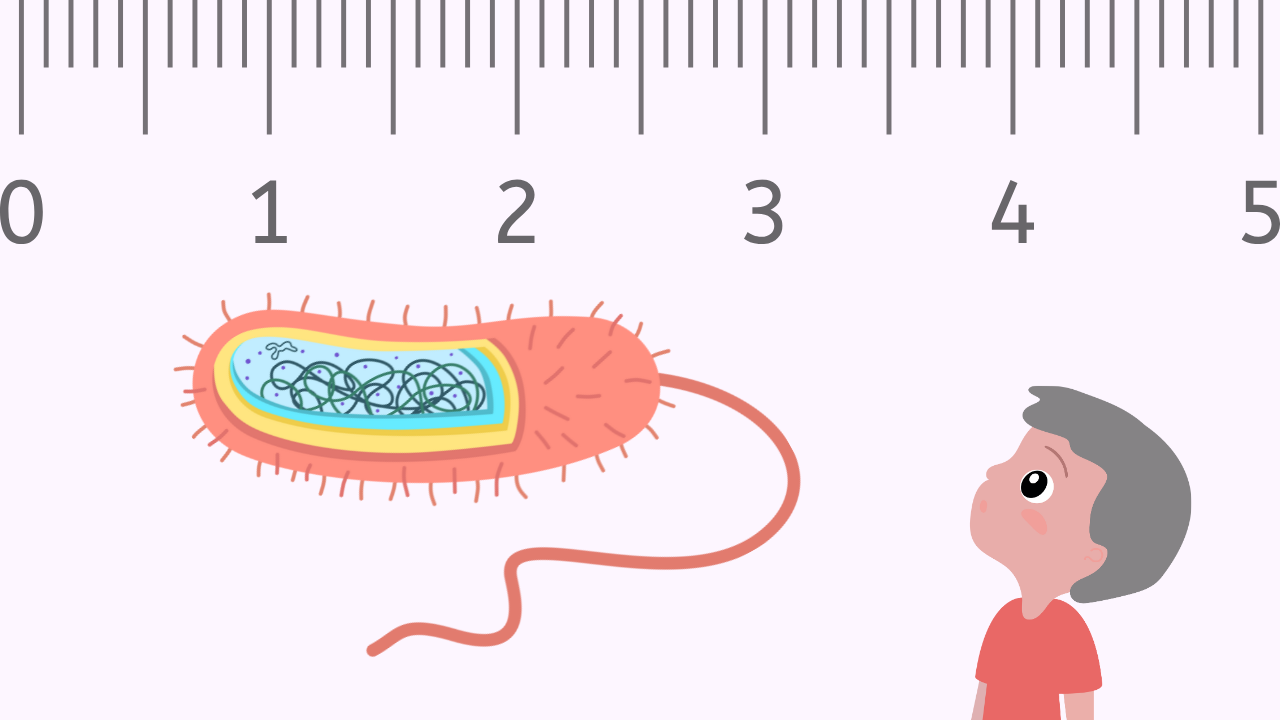Bacterial morphology refers to the size, shape, and arrangement of bacterial cells, which are key characteristics. These characteristics help identify and classify them. The most common shapes include cocci (spherical), bacilli (rod-shaped), spirilla (spiral), and vibrios (comma-shaped). Some bacteria may also form clusters, chains, or pairs, depending on how they divide and arrange themselves. Understanding bacterial morphology is important in microbiology because it helps in the preliminary identification of bacteria, their adaptation to environments, and their role in health and disease.
Understanding the Size of Bacteria
Before we talk about the size of bacteria, which is usually measured in micrometers, let us understand how small a micrometer is.
On a centimeter scale, you see each centimeter is divided into 10 millimeters. Imagine you have a millimeter, which is a unit of measurement often used to describe small lengths. Now, let’s break down this millimeter into smaller parts called micrometers.
A micrometer is one-thousandth of a millimeter. 1 µm = 1/1000 mm. That means if you were to slice that millimeter into one thousand equal pieces, each of those pieces would be a micrometer. Since we cannot draw 1000 dots, imagine these few dots as 1000 dots.
To put it in perspective, imagine lining up a thousand tiny dots along the length of that millimeter. Each dot represents one micrometer. So, if you were to look at a millimeter under a microscope, you’d see a thousand individual micrometers lined up next to each other.

That’s the scale we’re dealing with when we talk about bacteria. These microorganisms are so small that we can measure them only in micrometers. In fact, many bacteria are just a few micrometers in length, making them even smaller than a single millimeter. This gives you an idea of just how tiny bacteria are compared to the units of measurement we’re familiar with in everyday life. Since we cannot draw all the 1000 dots here, imagine these dots as 1000 dots.
The smallest size that a human being can typically see with the naked eye is around 0.1 millimeters, also known as 100 micrometers. Objects smaller than this become difficult or impossible to observe without the aid of magnification tools like microscopes.
Looking for quick facts about microbes? Try Microlookup, our free web app that gives you instant information on microorganisms.
Bacteria exhibit a remarkable diversity in size, ranging from the smallest known cells to larger and more complex forms. Most of the bacteria fall within the range of 0.2 µm to 10 µm in length. However, some bacteria can be even smaller, with diameters as tiny as 0.1 µm.
Among the smallest bacteria is the Mycoplasma, which is capable of passing through filters designed to trap common bacteria. In contrast, certain filamentous bacteria, such as members of the genus Thiomargarita, can reach lengths of up to 750 µm, making them some of the largest known bacterial cells. The size of bacteria influences various aspects of their physiology, including nutrient uptake, and surface-to-volume ratio. Despite their small size, bacteria exhibit remarkable adaptability and play essential roles in every ecosystem.
Bacteria exhibit different shapes that contribute to their adaptability and functionality in various environments. These shapes are primarily categorized into three main groups: cocci, bacilli, and spirilla. Understanding bacterial shapes is crucial for identifying and classifying different bacterial species.
Cocci (Spherical)
Cocci are bacteria with a spherical or round shape. They can occur in singles, in pairs, in chains, in clusters, or in groups. The arrangement of cocci is a key characteristic in bacterial classification. For example, Streptococcus pneumoniae forms pairs or chains, while Staphylococcus aureus forms clusters. The grouping of cells becomes one of their characteristics. Let us see the most common arrangement of cells in cocci bacteria.
Monococci – Single round-shaped cell
Diplococci – Cells divide in one plane and remain attached in pairs.
Streptococci – Cells divide in one plane and remain attached to form chains.
Tetrads – Cells divide in two planes and form a group of four cells.
Staphylococcus – Cells divide in three planes in an irregular pattern and form bunches.
Sarcina – Cells divide in three planes and form a cuboidal cell arrangement.

Bacilli (Rod-shaped)
Bacilli are bacteria with a rod-like shape. They can be short and plump or long and slender. Bacilli can exist in singles, in pairs, or in chains. Some bacteria, like Escherichia coli, are known for their typical rod shape, while others, like Bacillus subtilis, form long chains of rod-shaped cells.

Spirilla (Spiral or Helical)
Spirilla are bacteria with a spiral or helical shape. These bacteria may have a single, rigid spiral (spirillum) or a flexible corkscrew shape (spirochete). Helical bacteria, such as Spirillum volutans, demonstrate a distinctive corkscrew motion. Spirochetes, like Treponema pallidum, are characterized by a flexible helical shape and a unique method of motility.
In addition to these three main shapes, bacteria can also display other shapes. Let us see what those shapes are.
Coccobacilli are bacteria that exhibit an intermediate shape between cocci and bacilli. The term “coccobacillus” is used to describe bacteria that appear somewhat oval or short and plump, resembling a combination of both cocci and bacilli. Examples include some well-known bacteria like Haemophilus influenzae, a Gram-negative bacterium often associated with respiratory infections, and Bordetella pertussis, the causative agent of whooping cough.
Looking for quick facts about microbes? Try Microlookup, our free web app that gives you instant information on microorganisms.
Some bacteria have a distinctive curved or comma-shaped morphology. They are called vibrio. While they share some similarities with spirilla, their unique shape and slightly twisted flagellum set them apart. Vibrios represent a distinct bacterial shape that may not fit precisely into the traditional categories of cocci, bacilli, or spirilla. One example of bacteria with a vibrio shape is Vibrio cholerae. Vibrio cholerae is a Gram-negative bacterium, and its distinctive curved or comma-shaped morphology characterizes the vibrio shape.
Pleomorphic forms in bacteria refer to variations in cell shape and size within a bacterial population. Unlike bacteria with a defined and consistent shape, pleomorphic bacteria can exhibit a range of morphologies, making them more adaptable to different environmental conditions. Pleomorphism is often associated with changes in cell shape in response to alterations in the bacterial environment or during different stages of the bacterial life cycle.
The shapes of bacteria not only contribute to their ecological success but also play a crucial role in their interactions with other organisms and their adaptation. Understanding bacterial morphology is foundational to microbiology and is essential for identifying and studying these remarkable microorganisms.
Download the Bacterial Shapes Infographic Poster




